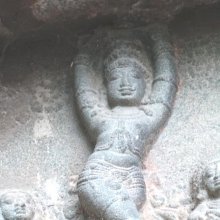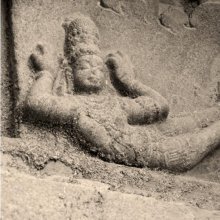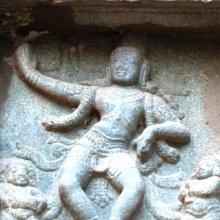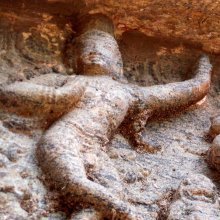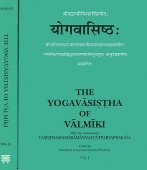Trika, Ṭrika: 18 definitions
Introduction:
Trika means something in Hinduism, Sanskrit, the history of ancient India, biology. If you want to know the exact meaning, history, etymology or English translation of this term then check out the descriptions on this page. Add your comment or reference to a book if you want to contribute to this summary article.
Images (photo gallery)
In Hinduism
Vyakarana (Sanskrit grammar)
Source: Wikisource: A dictionary of Sanskrit grammarTrika (त्रिक).—lit. triad; a term used in the Mahabhasya in connection with the Vibhakti affixes i.e. case endings and personal endings which are in groups of three; cf. त्रिकं पुनर्विभक्तिसंज्ञम् (trikaṃ punarvibhaktisaṃjñam) M.Bh. on P.I.1,38: cf. also कस्यचिदेव त्रिकस्य प्रथमसंज्ञा स्यात् (kasyacideva trikasya prathamasaṃjñā syāt) M. Bh. om P.I.4.101 ; cf. also M. Bh. on II.2.23, V.1.52, V.1.58.

Vyakarana (व्याकरण, vyākaraṇa) refers to Sanskrit grammar and represents one of the six additional sciences (vedanga) to be studied along with the Vedas. Vyakarana concerns itself with the rules of Sanskrit grammar and linguistic analysis in order to establish the correct context of words and sentences.
Chandas (prosody, study of Sanskrit metres)
Source: Shodhganga: a concise history of Sanskrit Chanda literatureTrika (त्रिक) is a technical term used in prosody (chandaśśāstra) especially, used to denote the gaṇas who have three letters each in Varṇa type of metres.

Chandas (छन्दस्) refers to Sanskrit prosody and represents one of the six Vedangas (auxiliary disciplines belonging to the study of the Vedas). The science of prosody (chandas-shastra) focusses on the study of the poetic meters such as the commonly known twenty-six metres mentioned by Pingalas.
Purana and Itihasa (epic history)
Source: archive.org: Shiva Purana - English TranslationTrika (त्रिक) is the name of a Sage (Muni) who once attended a great sacrifice by Dakṣa, according to the Śivapurāṇa 2.2.27. Accordingly as Brahmā narrated to Nārada:—“[...] once a great sacrifice was started by Dakṣa, O sage. To partake in that sacrifice, the celestial and terrestrial sages and devas were invited by Śiva and they reached the place being deluded by Śiva’s Māyā. [Trika, ...] and many others along with their sons and wives arrived at the sacrifice of Dakṣa—my son”.

The Purana (पुराण, purāṇas) refers to Sanskrit literature preserving ancient India’s vast cultural history, including historical legends, religious ceremonies, various arts and sciences. The eighteen mahapuranas total over 400,000 shlokas (metrical couplets) and date to at least several centuries BCE.
Shaivism (Shaiva philosophy)
Source: Google Books: The Bloomsbury Research Handbook of Vedanta (Shaivism)Trika (त्रिक) refers to the system of the non-dual traditions of Tantra Shaivism. The Trika tradition centers on the worship of three Goddesses: the benevolent Parā, and her fierce manifestations Parāparā and Aparā. The scriptures of the Trika include, among others, the Siddhayogeśvarīmatatantra (its earliest text dated to the seventh century), Mālinīvijayottara, Tantrasadbhāva, Parātrīśikā, and Vijñānabhairavatantra.

Shaiva (शैव, śaiva) or Shaivism (śaivism) represents a tradition of Hinduism worshiping Shiva as the supreme being. Closely related to Shaktism, Shaiva literature includes a range of scriptures, including Tantras, while the root of this tradition may be traced back to the ancient Vedas.
Ayurveda (science of life)
Source: gurumukhi.ru: Ayurveda glossary of termsTrika (त्रिक):—[trikam] 1. Sacral region or sacrum. The region behind the triangular bone situated dorsal and caudal from the two ilia between the fifth lumbar vertebra and coccyx. 2. region aroundshoulder girdle

Āyurveda (आयुर्वेद, ayurveda) is a branch of Indian science dealing with medicine, herbalism, taxology, anatomy, surgery, alchemy and related topics. Traditional practice of Āyurveda in ancient India dates back to at least the first millenium BC. Literature is commonly written in Sanskrit using various poetic metres.
India history and geography
Source: Cologne Digital Sanskrit Dictionaries: Indian Epigraphical GlossaryTrika.—(HA), a group of three figures of the Tīrthaṅkaras. Note: trika is defined in the “Indian epigraphical glossary” as it can be found on ancient inscriptions commonly written in Sanskrit, Prakrit or Dravidian languages.

The history of India traces the identification of countries, villages, towns and other regions of India, as well as mythology, zoology, royal dynasties, rulers, tribes, local festivities and traditions and regional languages. Ancient India enjoyed religious freedom and encourages the path of Dharma, a concept common to Buddhism, Hinduism, and Jainism.
Biology (plants and animals)
Source: Google Books: CRC World Dictionary (Regional names)Trika in India is the name of a plant defined with Desmodium gangeticum in various botanical sources. This page contains potential references in Ayurveda, modern medicine, and other folk traditions or local practices It has the synonym Pleurolobus maculatus J.St.-Hil. (among others).
Example references for further research on medicinal uses or toxicity (see latin names for full list):
· Repert. Bot. Syst. (Walpers) (1842)
· Prodromus Systematis Naturalis Regni Vegetabilis (1825)
· Fl. Indo-Chine (1920)
· Beskr. Guin. Pl. (1827)
· Methodus (Moench) (1794)
· Journal of Cytology and Genetics (1990)
If you are looking for specific details regarding Trika, for example pregnancy safety, diet and recipes, health benefits, extract dosage, side effects, chemical composition, have a look at these references.

This sections includes definitions from the five kingdoms of living things: Animals, Plants, Fungi, Protists and Monera. It will include both the official binomial nomenclature (scientific names usually in Latin) as well as regional spellings and variants.
Languages of India and abroad
Sanskrit dictionary
Source: DDSA: The practical Sanskrit-English dictionaryTrika (त्रिक).—a. [trayāṇāṃ saṃghaḥ kan]
1) Triple, three-fold.
2) Forming a triad; अव द्वके अव त्रिका दिवश्चरन्ति भेषजा (ava dvake ava trikā divaścaranti bheṣajā) Ṛgveda 1.59.9.
3) Three per cent; cf. Manusmṛti 8.152 Kull.
4) Happening the third time.
-kam 1 A triad; भक्तिः परेशानुभवो विरक्तिरन्यत्र चैष त्रिक एककालः (bhaktiḥ pareśānubhavo viraktiranyatra caiṣa trika ekakālaḥ) Bhāgavata 11.2.42.
2) A place where three roads meet.
3) The lower part of the spine, the part about the hips; पृष्ठवंशाधरे त्रिकम् (pṛṣṭhavaṃśādhare trikam) Ak. (Mar. mākaḍahāḍa); त्रिके स्थूलता (trike sthūlatā) Pañcatantra (Bombay) 1.19; कश्चिद्विवृत्तत्रिकभिन्नहारः (kaścidvivṛttatrikabhinnahāraḥ) R.6.16; छिन्नत्रिकास्तथा केचित् (chinnatrikāstathā kecit)...... Śiva. B.13.126.
4) The part between the shoulderblades.
5) The three spices.
-kā 1 A contrivance for raising water (like a wheel) over which passes the rope of the bucket.
2) The cover of a well.
Source: Cologne Digital Sanskrit Dictionaries: Shabda-Sagara Sanskrit-English DictionaryTrika (त्रिक).—n.
(-kaṃ) 1. The lower part of the spine. 2. The aggregate of three, a trine, a triad. 3. The three mystical words to be pronounced in daily prayer. 4. A place where three roads meet. 5. Three spices, three myrobalans, &c. collectively: see trikaṭu, triphala and the like. m.
(-kaḥ) A plant: see gokṣuraka. f.
(-kā) 1. A triangular frame or bar across the mouth of a well over which passes the rope of the bucket, or to which one end of it is tied to guard against its slipping. 2. A wooden frame at the mouth of a well, or the upper part of the well. 3. A frame at the bottom of a well, on which the masonry rests. 4. The cover or lid of a well. E. tri three, and kan aff.
Source: Cologne Digital Sanskrit Dictionaries: Benfey Sanskrit-English DictionaryTrika (त्रिक).—[tri + ka], I. adj. 1. Forming a triad, [Suśruta] 1, 158, 2. 2. (suppl. śata), Three per cent. [Mānavadharmaśāstra] 8, 142. 3. (A place) where three roads meet, [Harivaṃśa, (ed. Calc.)] 6501. Ii. n. 1. A triad, Mahābhārata 12, 7954. 2. The chine-bone, [Raghuvaṃśa, (ed. Stenzler.)] 6, 16. 3. The hip, [Pañcatantra] i. [distich] 205.
Source: Cologne Digital Sanskrit Dictionaries: Cappeller Sanskrit-English DictionaryTrika (त्रिक).—[adjective] trine, forming a triad, consisting of three; ± śata three per cent. —[masculine] a triangular place or yard; [neuter] a triad.
Source: Cologne Digital Sanskrit Dictionaries: Monier-Williams Sanskrit-English Dictionary1) Trika (त्रिक):—[from tri] mfn. triple, threefold, forming a triad, [Ṛg-veda x, 59, 9.; Lāṭyāyana] (Stoma; cf. eka-), [Śulba-sūtra i; Suśruta] etc.
2) [v.s. ...] happening the 3rd time, [Pāṇini 5-2, 77]
3) [v.s. ...] (with or without śata) 3 per cent, [Manu-smṛti viii, 152; Manvarthamuktāvalī, kullūka bhaṭṭa’s Commentary on manu-smṛti]
4) [v.s. ...] m. (n., [cf. Lexicographers, esp. such as amarasiṃha, halāyudha, hemacandra, etc.]) a place where 3 roads meet, [Harivaṃśa; Jaina literature]
5) [v.s. ...] = tri-kaṭa, [Nighaṇṭuprakāśa]
6) [v.s. ...] Trapa bispinosa, [ib.]
7) [v.s. ...] n. a triad (cf. kaṭu-, taurya-, tri-, pañca-), [Manu-smṛti ii, vii; Patañjali] and, [Kāśikā-vṛtti; Varāha-mihira’s Bṛhat-saṃhitā]
8) [v.s. ...] the loins, regio sacra, hips, [Harivaṃśa; Pañcatantra; Suśruta] (also ‘the part between the shoulder-blades’) etc.
9) [v.s. ...] the triple Vyāhṛti, [Horace H. Wilson]
10) Trikā (त्रिका):—[from trika > tri] f. a triangular frame across the mouth of a well, [cf. Lexicographers, esp. such as amarasiṃha, halāyudha, hemacandra, etc.]
Source: Cologne Digital Sanskrit Dictionaries: Yates Sanskrit-English DictionaryTrika (त्रिक):—(kaṃ) 1. n. The lower part of the spine; a triad; om; place where three roads meet. f. Lid of a well.
Source: DDSA: Paia-sadda-mahannavo; a comprehensive Prakrit Hindi dictionary (S)Trika (त्रिक) in the Sanskrit language is related to the Prakrit word: Tia.
[Sanskrit to German]
Sanskrit, also spelled संस्कृतम् (saṃskṛtam), is an ancient language of India commonly seen as the grandmother of the Indo-European language family (even English!). Closely allied with Prakrit and Pali, Sanskrit is more exhaustive in both grammar and terms and has the most extensive collection of literature in the world, greatly surpassing its sister-languages Greek and Latin.
Kannada-English dictionary
Source: Alar: Kannada-English corpusTrika (ತ್ರಿಕ):—
1) [noun] = ತ್ರಿ [tri]2.
2) [noun] a set or group of three; a triad.
3) [noun] the quantity that is three times the another quantity.
4) [noun] the back the hips that forms most fleshy part of the body, and on which one sits; the buttocks.
5) [noun] a happening for the third time.
6) [noun] a junction of three roads.
Kannada is a Dravidian language (as opposed to the Indo-European language family) mainly spoken in the southwestern region of India.
Nepali dictionary
Source: unoes: Nepali-English Dictionary1) Ṭrika (ट्रिक):—n. trick; cleverness;
2) Trika (त्रिक):—n. 1. a collection of three numbers or objects; 2. the lower part of a spinal cord;
3) Trika (त्रिक):—adj. 1. threefold; 2. three percentage;
Nepali is the primary language of the Nepalese people counting almost 20 million native speakers. The country of Nepal is situated in the Himalaya mountain range to the north of India.
See also (Relevant definitions)
Starts with (+88): Trikabheda, Trikadarshana, Trikadruka, Trikadrukiya, Trikagnikalaya, Trikahridaya, Trikaika, Trikaka, Trikakubdhama, Trikakubh, Trikakud, Trikakuda, Trikakut, Trikala, Trikalabhoga, Trikaladarshi, Trikaladarshin, Trikalagocara, Trikalahasti, Trikalajna.
Ends with (+490): Abhartrika, Abhastrika, Abhidhavrittimatrika, Abhilashapurayitrika, Abhiyantrika, Abhratrika, Adevamatrika, Adhyanumatrika, Agnihotrika, Ahicchattrika, Aikaratrika, Ajinapatrika, Ajinapattrika, Akartrika, Akarttrika, Akhyapayitrika, Alipatrika, Alipattrika, Alpapatrika, Alpapattrika.
Full-text (+208): Phalatrika, Aputraka, Tauryatrika, Matraka, Patraka, Aputra, Ekatrika, Trikasthana, Tia, Ashtatrika, Trikagnikalaya, Trikaika, Trikatraya, Ratraka, Trick, Devaputraka, Gatraka, Trikahridaya, Khanitraka, Trikasara.
Relevant text
Search found 41 books and stories containing Trika, Trikā, Ṭrika; (plurals include: Trikas, Trikās, Ṭrikas). You can also click to the full overview containing English textual excerpts. Below are direct links for the most relevant articles:
Manusmriti with the Commentary of Medhatithi (by Ganganatha Jha)
Verse 2.79 < [Section XVII - Rules of Study]
Verse 8.142 < [Section XXV - Rates of Interest]
Verse 7.51 < [Section IV - Duties of the King]
Rig Veda (translation and commentary) (by H. H. Wilson)
Rig Veda 10.59.9 < [Sukta 59]
Sahitya-kaumudi by Baladeva Vidyabhushana (by Gaurapada Dāsa)
Text 10.107 < [Chapter 10 - Ornaments of Meaning]
Text 7.2 < [Chapter 7 - Literary Faults]
Text 1.5 < [Chapter 1 - The Purpose of Poetry]
A History of Indian Philosophy Volume 2 (by Surendranath Dasgupta)
Part 2 - Bones in the Atharva-veda and Āyurveda < [Chapter XIII - Speculations in the Medical Schools]
Later Chola Temples (by S. R. Balasubrahmanyam)
Temples in Argal (Argalur) < [Chapter XII - Temples of Kulottunga III’s Time]
Cidgaganacandrika (study) (by S. Mahalakshmi)
Part 2a - Trika Philosophy (Introduction) < [Krama system and Trika school]
Part 1a - Krama system (Introduction) < [Krama system and Trika school]
Verse 297 [Trika principle of Nara-Śakti-Śiva] < [Chapter 4 - Fourth Vimarśa]
Related products
